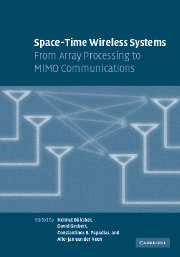Book contents
- Frontmatter
- Contents
- List of contributors
- Acknowledgments
- Introduction
- Part I Multiantenna basics
- Part II Space-time modulation and coding
- 7 Introduction to space-time codes
- 8 Perspectives on the diversity-multiplexing trade-off in MIMO systems
- 9 Linear precoding for MIMO channels
- 10 Space-time coding for noncoherent channels
- 11 Space-time coding for time- and frequency-selective MIMO channels
- Part III Receiver algorithms and parameter estimation
- Part IV System-level issues of multiantenna systems
- Part V Implementations, measurements, prototypes, and standards
- Index
8 - Perspectives on the diversity-multiplexing trade-off in MIMO systems
Published online by Cambridge University Press: 25 February 2010
- Frontmatter
- Contents
- List of contributors
- Acknowledgments
- Introduction
- Part I Multiantenna basics
- Part II Space-time modulation and coding
- 7 Introduction to space-time codes
- 8 Perspectives on the diversity-multiplexing trade-off in MIMO systems
- 9 Linear precoding for MIMO channels
- 10 Space-time coding for noncoherent channels
- 11 Space-time coding for time- and frequency-selective MIMO channels
- Part III Receiver algorithms and parameter estimation
- Part IV System-level issues of multiantenna systems
- Part V Implementations, measurements, prototypes, and standards
- Index
Summary
Introduction
Multiple-element antenna arrays have an important role to play in both improving the robustness of wireless transmission through spatial diversity and increasing the throughput of wireless links through spatial multiplexing. Indeed, a wide variety of coding and signal processing techniques have been developed to realize one or the other of these benefits, or combinations of the two.
In recent years there has been an increasing appreciation that the two types of gains are inherently coupled. In particular, for a given antenna configuration, large robustness gains preclude the possibility of large throughput gains, and vice-versa. While the detailed nature of the fundamental trade-off between these gains is rather complicated, in the high signal-to-noise ratio regime, the scaling behavior of this diversity-multiplexing trade-off takes a particularly simple form.
To facilitate the use of this trade-off by communication engineers in system design, this chapter provides an intuitive development of the trade-off. In addition, we illustrate how a number of systems make these trade-offs efficiently in various regimes of interest. In the process, a variety of additional interpretations and perspectives on the underlying relationships are developed.
An outline of the chapter is as follows. We begin with a basic channel model and some definitions. We then proceed to develop and interpret the efficient frontier of diversity-multiplexing trade-offs. The remainder of the chapter focuses on how to achieve different portions of the frontier, what it means to operate on the frontier, and on how performance degrades when operating away from the frontier.
- Type
- Chapter
- Information
- Space-Time Wireless SystemsFrom Array Processing to MIMO Communications, pp. 154 - 177Publisher: Cambridge University PressPrint publication year: 2006



